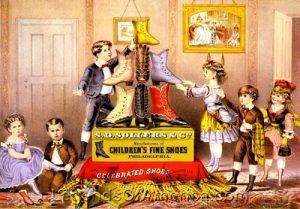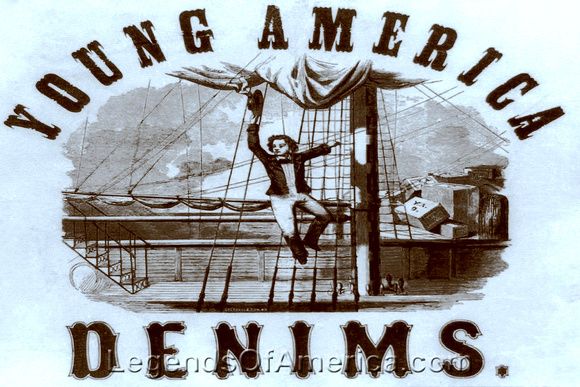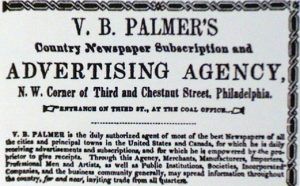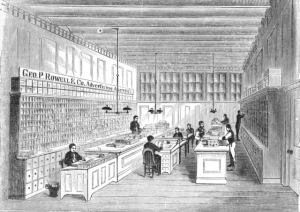by Sam Bocetta
Just like with any profession or trade, real legends always emerge to become the authorities in the field. These authorities combine the experience and skills they have acquired to create definitive and defining works.
Advertising in early 19th century America was no exception to this rule. The earliest American ad men did print advertisements used primarily to promote books and newspapers, which became increasingly affordable with advances in the printing press, and medicines, which were increasingly sought after as modern Americans rejected many “old world” cures.
Origins
Volney Palmer, a Philadelphia, Pennsylvania native, in 1841 created the original advertising agency in early America. For the next several years, his company began to broker and sell space in some of the earliest American magazines and newspapers. This continued until the late 19th century when advertising businesses started structuring themselves to something similar to those we still see operating today.
These early advertising agencies brokered space like their cousins and helped with advertising and marketing problems. They also created graphic illustrations that would be used as ads in various publications.
The amount of ad space available in newspapers increased quickly. It is reported that the Boston Transcript published 19,000 ads in 1860, 87,000 in 1900, and 237,000 in 1918.
The First Legend
Around this same time, a man named George P. Rowell wrote what some call the first book specifically targeted at the advertising business. Rowell then went on to open an advertising agency in 1865 located in Boston, Massachusetts.
His work is why we have records of some of the earliest American newspapers due to his creation of the American Newspaper Directory in 1869. This archive was the first effort in early America to record the publication figures of newspapers around the growing country. This was an essential tool for early American advertising.
In 1870, Rowell published The Men Who Advertise: An Account of Successful Advertisers, Together with Hints on the Methods of Advertising. The Philadelphia agency N.W. published the only other manual at the time. Ayer & Son; titled The Science of Advertising: A Manual for Advertisers, which was published in 1874.
A Growing Need

S.D. Sollers & Co., Manufacturers of Children’s Fine Shoes, Philadelphia, Pennsylvania, 1874 advertisement
The need for advertising increased substantially in the United States after 1870 as industrialization expanded across America so it could distribute products to an ever-growing market. To profit from this higher production rate, businesses needed to recruit their own workers as consumers of factory products.
You may have heard of the “Company Store” before, and these two things go hand in hand. So, the need for advertising grew as products were designed to meet the growing U.S. population’s needs on a larger scale.
The total advertising spending in the U.S. went from about $200 million in 1880 to nearly $3 billion after the turn of the century. In the late 1800s, most advertising was done by a handful of companies, numbering only 150.
The records also show that these 150 companies spent around $50,000 each on advertising. By today’s standards, that equates to $1,300,000 in modern times.
Contrasting that to the commerce statistics you see today, you can see that advertising has increased by a huge margin. Some cite statistics that show the ad spending in 2017 to be more than $205 billion. This is due largely to advances in Internet advertising, which have recently eclipsed T.V. spending as the preferred way companies place ads.
T.V. ad spending only accounts for $192 billion, $13 billion less than online advertising. This is because approximately 95% of consumers in America now shop online as opposed to the physical catalogs used in early America.
And consumers today are also feeling advertisement fatigue more than ever before. This is shown by the widespread use of “ad blocker” software that some say costs businesses around $22 billion a year due to ads not being seen by those using ad blockers. Things have changed a lot when you compare where advertising is now to the early American advertising industry.
Knowledge & Power
After this, very few other books were published outlining the advertising process in early America until almost a decade later. Soon, smaller books and instruction manuals started appearing, but nothing as comprehensive as the works of the aforementioned authors until closer to 1900.
At this time, several specialty manuals were published on the topics of sign painting, copywriting, window display design, & advertising psychology. Sometime later, the topics of advertising economics, media, & others designed for specific industries began to be published.
Sometime near 1905, Rowell could assess and catalog his career that had spanned some four decades. He then wrote “Forty Years An Advertising Agent,” which some say was the first memoir by an expert in early American advertising.
As you expect, early advertising incorporated clever designs and copy reflecting the time. These styles are still used today, with online websites championing old-fashioned imagery.
Conclusion
Unfortunately, there aren’t many records and catalogs of the earliest American advertising. However, works by noted advertising men such as Ernest Elmo Calkins and Roy Durstine are still available.
There also are promotional books for other advertising agencies and product companies. Several publications illustrate the outdoor advertising industry if you know where to look.

©Sam Bocetta for Legends of America, January 2019. Updated by Kathy Alexander/Legends of America, February 2024.
Sam Bocetta is a retired computer engineer who spent much of his career tinkering with Naval ballistics and EWTR systems. Sam now writes for The Strategy Bridge as an independent correspondent and teaches part-time at Algonquin Community College in Ottawa, Canada. Find him on Linkedin
Also See:
Author Submissions to Legends of America



